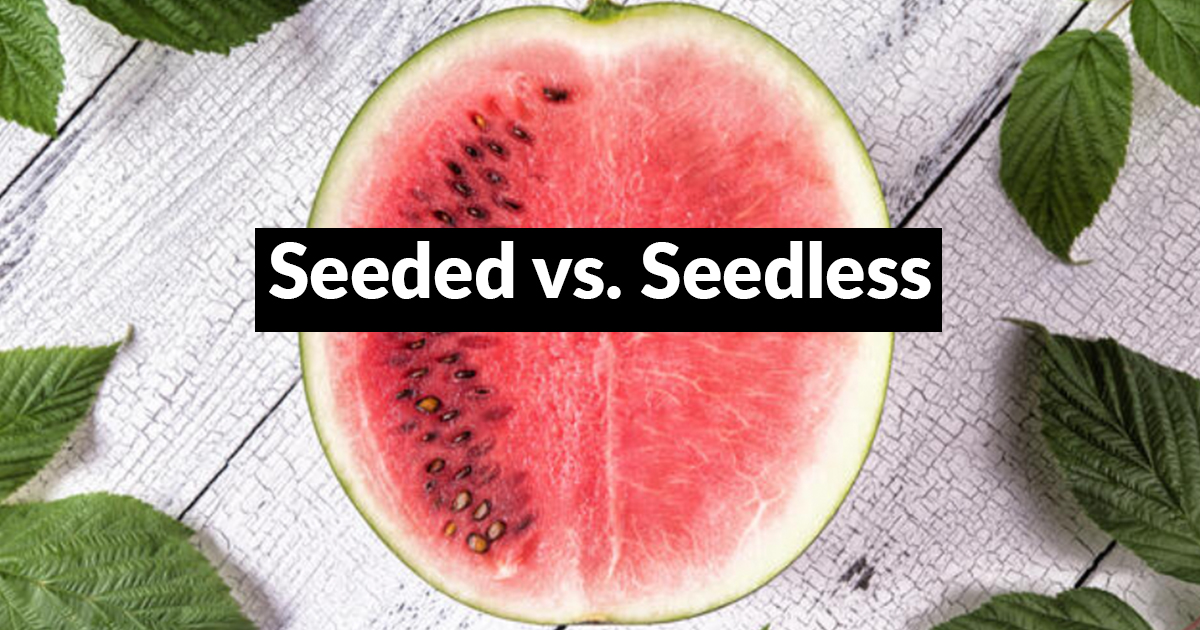It’s hot outside, and my daughters and I love watermelon. We get to the store, and they’re in season—bright red, juicy, and refreshing. Even better, the seedless watermelons are on sale. I’m excited and grab six of the volleyball-sized ones.
As we’re checking out, someone recognizes me as a nutritionist and says,
“I’m surprised to see you buying seedless watermelons. I would’ve never thought you’d feed your kids GMO food.”
Not sure if that was a question, a statement, or an insult—but it inspired me to write this article.
Because the truth is, there’s a lot of confusion about seedless vs. seeded watermelon, and whether one is healthier or “more natural” than the other. So let’s clear up the myths—and I promise, by the time you finish reading, you’ll be able to enjoy your favorite watermelon without guilt or doubt.
Seedless Watermelon Is Not Genetically Modified
Despite what you may have heard, seedless watermelon is not a genetically modified organism (GMO). This means it’s not created in a lab using genetic engineering. Instead, seedless watermelon is developed through a natural crossbreeding technique known as triploid hybridization (Maynard, 2001).
Here’s the science in simple terms:
-
- Seedless watermelons are grown by crossing a watermelon with 2 sets of chromosomes (2n) with one that has 4 sets (4n), created by treating plants with colchicine.
- This creates a triploid plant (3n) that can grow fruit but can’t produce mature seeds (Zhang et al., 2017).
- No gene splicing. No DNA editing. Just smart plant breeding, and the result is a juicy, sweet watermelon that’s easier to eat.
Are Seeded Watermelons Healthier?
Some people believe that seeded watermelons must be more nutritious—but the truth is, both types are loaded with health benefits, including:
-
- Hydration – Watermelon is over 90% water, making it perfect for hot days and active lifestyles.
- Lycopene – This powerful antioxidant may support heart health and reduce inflammation (Perkins-Veazie et al., 2001).
- Citrulline – An amino acid that supports healthy blood flow and may reduce muscle soreness (Collins et al., 2007).
- Vitamin C & A – Great for your immune system and skin.
The seeded variety does contain edible black seeds, which are rich in magnesium, zinc, and healthy fats—but you’d have to eat quite a few to make a significant difference.
What If Every Watermelon Were Seedless?
Here’s something most people don’t realize:
Seedless watermelons can’t reproduce.
They’re sterile, which means they don’t produce viable seeds that farmers can plant to grow more watermelons (Zhang et al., 2017).
So… what would happen if every watermelon on Earth was seedless?
We’d be in trouble.
No seeds = no next generation of watermelon plants.
But here’s the good news: Seeded watermelons are still grown and maintained to preserve the future of watermelon. Farmers use seeded watermelons to create the parent plants needed for seedless varieties.
Why You Don’t Need to Worry
Both seeded and seedless watermelons are grown every year on farms. The seedless ones are produced by carefully crossing specific varieties in controlled settings — and this process starts with seeds from the original, seeded plants.
That means:
-
- You can enjoy seedless watermelon for convenience
- You can choose seeded watermelon if you like to chew the seeds or feel nostalgic
- And either way, you’re supporting the future of the fruit
There’s no danger that seedless watermelons will replace all others or lead to a shortage. It’s a perfect example of how science and farming work hand-in-hand with nature.
The Takeaway
The next time you hear someone say, “Seedless watermelon isn’t real!” you can smile and say:
“Actually, seedless watermelon is 100% real — and made possible thanks to the seeded ones.”
You’re not just eating fruit.
You’re part of a smart, sustainable food system that gives you options — and keeps watermelons growing for generations to come.
References
-
- Collins, J. K., Perkins-Veazie, P., & Roberts, W. (2007). Watermelon consumption increases plasma arginine concentrations in adults. Nutrition, 23(3), 261–266. https://doi.org/10.1016/j.nut.2007.01.005
- Maynard, D. N. (2001). Watermelons: Characteristics, production, and marketing. ASHS Press.
- Perkins-Veazie, P., Collins, J. K., & Davis, A. R. (2001). Lycopene content differs among red-fleshed watermelon cultivars. Journal of the Science of Food and Agriculture, 81(10), 983–987. https://doi.org/10.1002/jsfa.882
- Zhang, X., Li, Z., & Huang, X. (2017). Production of seedless watermelon by triploid breeding. In S. Mangal (Ed.), Advances in Horticultural Science. Academic Press.
__________
Robert Ferguson is a California- and Florida-based single father of two daughters, nutritionist, researcher, best-selling author, speaker, podcast and television host, health advisor, NAACP Image Award Nominee, creator of the Diet Free Life methodology, and Chief Nutrition Officer for iCoura Health. He also serves on the Presidential Task Force on Obesity for the National Medical Association and the Health and Product Advisory Board for Zinzino, Inc.


Awesome! Thank you for this insightful article!
Very good read. Thank for clarifying differences, watermelon and seedless watermelon.
nah, you can keep eating the hybridized frankenfoods, i’ll stick to non-hybridized ancient foods my aborigine American indian ancestors ate. That’s the only way to really stay healthy and not a pawn of big pharma, same with gluten (for instance einkorn vs modern day convention wheat). I’ve helped enough already. My watermelon is nonhybrid, non-gmo, and I visit the farm.
Another aspect… IF you are a genetic clone, then a hybrid/clone/frankenfood is fine. But not everyone are genetic clones or from the cabbage patch, those melanated people need high vibrational living food and lots of sun without hiding under an Umbrella from the Son of God. They not the same.